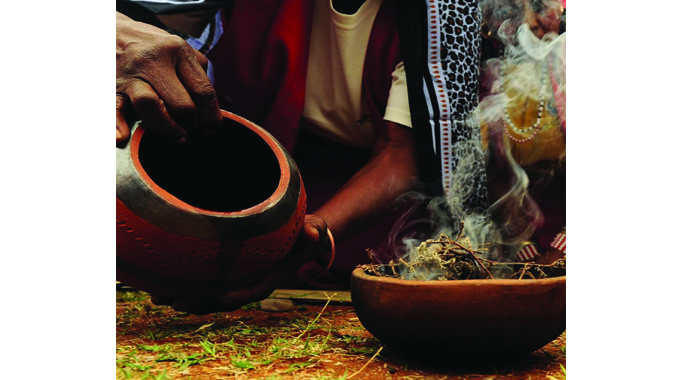Initiation into the spirit world: Transforming a potential to reality (Part 1)

Pathisa Nyathi, Opinion
I WAS surfing the internet in the hope of gleaning more information on African Spirituality. Unexpectedly, I came across a site that carried an article that I penned for Chronicle not so long ago. The site gave a South African address – (.co.za). Of course, I was happy to realise that there are people out there who are following my works.
However, the more important point was my realisation that I had promised to do a number of articles on spirituality. What inspired the envisaged articles was the desire to explain the preponderance among some Christian churches of schisms.
My idea in seeking some explanations was premised on the idea that spirituality does play a part in the emergence of schisms that occur. At the same time, the schisms may be viewed as the necessary growth that precedes development. Meiosis in cells takes place if a body is to grow, develop and diversify in complexity and functioning. There are types of Christian churches that seem susceptible to and are afflicted by the phenomenon of schism while it is not the case with others.
I therefore for embarked on a search for a better understanding of the spirit, spiritism, spirituality and spiritualism. It was against this background that my first port of call was to unpack the concept and related aspects of a spirit, its manifestations, architecture and maturity right up to men and women of spirit, who sometimes seem to prefer to call themselves Men or Women of God.
From an African perspective, for one to become a spiritual host begins at conception. The potential is laid then, when the male sperm and female ovum fuse to form a zygote that will, after a gestation period of nine months, be ready to leave its comfort zone within the mother’s womb to become a baby in the dry world where the body interacts with the atmosphere and the zones beyond it.
At this stage, all that exists is a mere potential that will transform into fruition following biological and mental maturity. Sometimes even before that time comes there may be some tell-tale signs that the little person is spiritually endowed. The person may experience dreams whose events do come to pass. Sometimes the dreams feature certain snakes, which are associated with African spirituality such as the python.
For others, their dreams may feature water bodies or flowing water and even going up challenging mountains. Some develop dislike foods such as eggs, onions, mutton, lamb, bacon and pork. Odours from some of the foods may be revolting to the immature spirit resident in an immature being.

Eggs. Image taken from Britannica
It certainly does seem sacredness influences preferred tastes. Some observant parents may quickly realise that their child is behaving rather strangely. Being more experienced, they would suspect spiritual presence in their child.
It is important that we realise that here we are referring to the neutral Ancient African Science (AAS) which is accessed and harnessed by different people for either evil or good purposes or both. When we refer to spirituality, we are embracing both the evil and the good. Spiritual maturity does not happen effortlessly.
There are associated rituals that precede its attainment. That is the stage when an individual plays envisaged roles within a family, lineage or community.
It is at this stage that the host or medium experiences inexplicable illnesses. The period may be very traumatic and stressful.
The stage is an inevitable and sufficient condition for the performance of the rites of passage to a world of fully expressed and functioning spirituality. The illness and sometimes — other misfortunes may be difficult to diagnose through Western health methodologies. Experience shows that such illnesses may be of a sacred nature and demand that they be attended to in the appropriate manner — a spiritual one.
Illness may be a very culturally contextual condition. An illness that exhibits similar or the same signs and symptoms may be interpreted differently depending on the world-view and health traditions of a given community. Where there are spiritual issues Western medical technology may not work.
It is a health technology designed and developed within the context of Western ideas and beliefs, which are not universal. Their health technologies do not attend to the spiritual aspects as posited by Africans. People behave, as they believe.
For the African peoples, who posit a Duality of Being that a human being encompasses both material and spiritual components, both aspects of being must be attended to. Spiritual issues and conditions demand spiritual interventions. Likewise, physical conditions demand physical interventions. The African being is more complex and dealing with his/her health issues may demand a more holistic approach, one that takes care of both aspects.
Those destined to become men and women of spiritual work have to undergo vigorous and strenuous initiation in order that the individuals are well prepared for their roles in adult life. Spiritual engagements are not for the young at heart and body.
Initiation is thus undergone to transform and realise potential spiritual endowment into functionality.
The womb and the tomb are very important stages in human-spiritual development. The two stages mark the transitions to higher stages where more knowledge and wisdom is acquired. An individual is born with a mere potential. After birth, he/she starts the process of learning, which, in essence, is acquiring knowledge from peers and the elders. In fact, the individual may draw knowledge from beyond the realm of the living.

Image taken from shutter stock
Spirituality exists, among other purposes, to access past experiences, knowledge and traditions so that there is no need to reinvent the wheel. However, that knowledge is stored beyond the tomb. It is knowledge that is accessed by those who have passed through the doors of death.
The living, who are spiritually endowed, are enabled through spiritual channels of communication, to link up with the dear departed spirits in the underworld and receive the knowledge and information along the safeguarded channels to ensure spiritual and intellectual rights are protected.
The spirits, it seems to me, have transmitters and the living who are spiritually endowed possess the requisite antennae to receive the messages from the underworld.
The question is initiation for what? The same question may be paraphrased as spirituality for what? Generally, what is observed is that initiation is equivalent to spiritual attachment. It marks an important transformative stage when an individual acquires a stage of accumulated knowledge that is more advanced, skills, new responsibilities and obligations.
When it comes to the world of Spiritism, the individual must undergo certain rituals that ensure attainment of spiritual maturity and therefore readiness to dispense the requisite knowledge and skills.
The distance between the living and the living dead, if we may borrow Professor John Mbiti’s terminology, in physical or material terms that we are used to as human beings does not exist. It is so near and yet so far away, when the requisite rituals have not been performed.

Professor John Mbiti
This is where initiation comes in to bridge the gap or gulf between the living and the dear departed who, in their newly acquired statuses, are able to glean past knowledge and traditions. Their duty it is to pass these down to future generations. The spaces are around us are replete with a wide range of information and knowledge being beamed from the sources of preserved knowledge.
Unfortunately, we are not able to tune in to the right frequencies to intercept them.
What all this points to is that spiritual leaders have to undergo rigorous training as part of their initiation to relate meaningfully to the spirit world from which they ought to derive their wisdom, knowledge, leadership traits and a lot more. To simply get up one morning, form a church, and impose oneself on the flock may not work. Men and women of spirit are those who have gone through the rigours of the mill.
It seems another article will have to be penned to deal more exhaustively with the concept of initiation during which an individual is equipped adequately with the knowledge, skills and ethical considerations relating to their future work. It is work that deals with a flock that is characterised by a Duality of Being.
However, that flock comprises men and women of flesh and spirit. The two dimensions demand being taken care of. Inevitably, that places a heavy burden on a spiritual leader.
It is not suggested that, in the case of witchcraft, there is no initiation. We shall however, deal more exhaustively with the aspects that are in the public domain and not as hidden as the profession that is peddled in the comfort of darkness or the absence of light.
Witchcraft is as much a spiritual phenomenon in the same mould as traditional divination and healing. After all, witches may serve as healers while traditional doctors may ply the profession of witches and wizards, albeit in broad daylight.












Comments